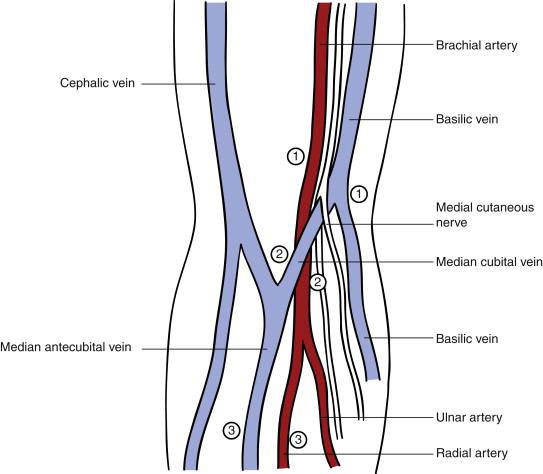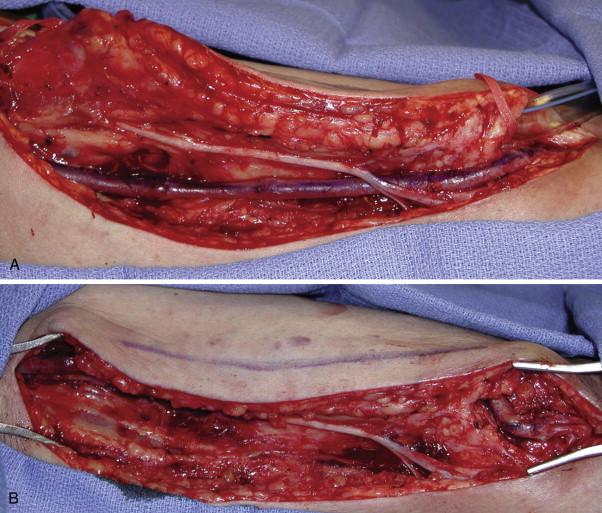Physical Address
304 North Cardinal St.
Dorchester Center, MA 02124
In 1976 Dagher and colleagues reported a series of 23 upper arm basilic vein transpositions for hemodialysis. The procedure did not achieve widespread acceptance until after the first National Kidney Foundation’s Kidney Disease Outcomes Quality Initiative (KDOQI) guidelines were published in 1997. The first large series of femoral vein transpositions was published by Gradman and associates in 2001. The procedures are analogous but differ in their indications, magnitude, technique, and complications.
An upper arm basilic vein transposition should be considered whenever a forearm fistula fails or is not feasible. Preference should be given to either a brachiocephalic fistula or a basilic vein transposition, depending on vein size.
Preserving veins. Antecubital venipuncture should be discouraged and the jugular vein should be used used whenever possible for intravenous lines or pacemaker wires to preserve axial vein integrity.
Preoperative imaging. Duplex ultrasound with a proximal tourniquet can be used to determine the size of the basilic and cephalic veins and identify common anatomic variations. Duplex ultrasound is best conducted when the patient is hydrated, in a warm environment, and free of anxiety. Veins should be marked and sized on a nondialysis day to limit venoconstriction associated with volume shifts. Patients with long-standing ipsilateral central venous catheters, pacemakers, or previous dialysis catheters should have an imaging study to rule out central venous occlusive disease.
Venous variations. The basilic vein occasionally joins the brachial vein in the midarm, rather than in the axilla. Antecubital vein variations are common. The median cubital vein, which extends from the midantecubital fossa to join the basilic vein, may be diseased, atretic, or nonexistent.
Nerve injury. The medial antebrachial cutaneous nerve of the forearm, a sensory nerve originating directly from the medial cord of the brachial plexus, crosses directly in front of the basilic vein at or just central to the entry of the median cubital vein. Dividing this nerve can lead to medial forearm anesthesia. The median nerve lies medial to the brachial artery at the level of the elbow and must be protected from injury during dissection and retraction.
Steal syndrome
Surgeons may choose to construct a basilic vein transposition in one or two stages. The single-stage procedure is cost effective but results in a higher frequency of primary failures. The two-stage procedure is most beneficial when the upper arm veins are of borderline size (2.5-3.5 mm; Fig. 65-1 ). A one-stage basilic vein transposition usually matures if the basilic vein is larger than 3.5 mm, but a two-stage basilic vein transposition should be constructed if the vein is between 2.5 and 3.5 mm. If the basilic vein is smaller than 2.5 mm, failure is common.

Whether done in one or two stages, the basilic vein must be transected distally and care must be taken to avoid injury to the medial antebrachial cutaneous nerve, which crosses anterior to the basilic vein at or just before the entry of the median cubital vein ( Fig. 65-2 , A ). Surgeons often encounter a stout large branch between the basilic and the brachial veins in the midarm. They should ligate or, if necessary, suture this branch carefully to avoid narrowing the lumen of the basilic vein. The basilic vein also occasionally joins the brachial vein in the midarm. Experience shows that if extra length is needed, the brachial vein may be harvested in continuity to the axilla without resulting in disabling postoperative arm edema. The brachial vein may be the dominant arm vein and can be used when no other autogenous vein is available. However, it is more fragile and has more branches than the basilic vein. The basilic vein should be freed to the proximal arm, marked to maintain orientation and tunneled over the anterior arm before anastomosis of the vein onto the brachial artery. Mere elevation of the vein makes for awkward cannulation and uncomfortable dialysis ( Fig. 65-2 , B ). The basilic vein can also be harvested endoscopically or via a “keyhole” technique. The benefit of decreased incisional pain has not been established.

Steal syndrome occurs less frequently with a basilic vein transposition (<4%) than with a prosthetic bridge graft. Upper arm fistulas may be originated from the proximal radial artery to reduce the incidence of steal syndrome.
Preoperative duplex vessel mapping is essential and may be assisted by placing a tourniquet on the proximal arm with gentle massage of the venous column centrally to distend the vein. Prophylactic antibiotics should be administered. Supraclavicular brachial plexus block can be used for anesthesia, along with 0.5% to 1.0% lidocaine to infiltrate the line of incision. Additional lidocaine can be administered into the fascial compartment. General anesthesia may be an alternative. The harvest incision extends the full length of the upper arm to the axilla. Exposure of the vein may begin anywhere along its length, but the venous anatomy is most reliably defined either in the axilla or at the median cubital vein. The basilic vein distal from its junction with the median cubital vein is occasionally harvested to gain additional length.
Become a Clinical Tree membership for Full access and enjoy Unlimited articles
If you are a member. Log in here